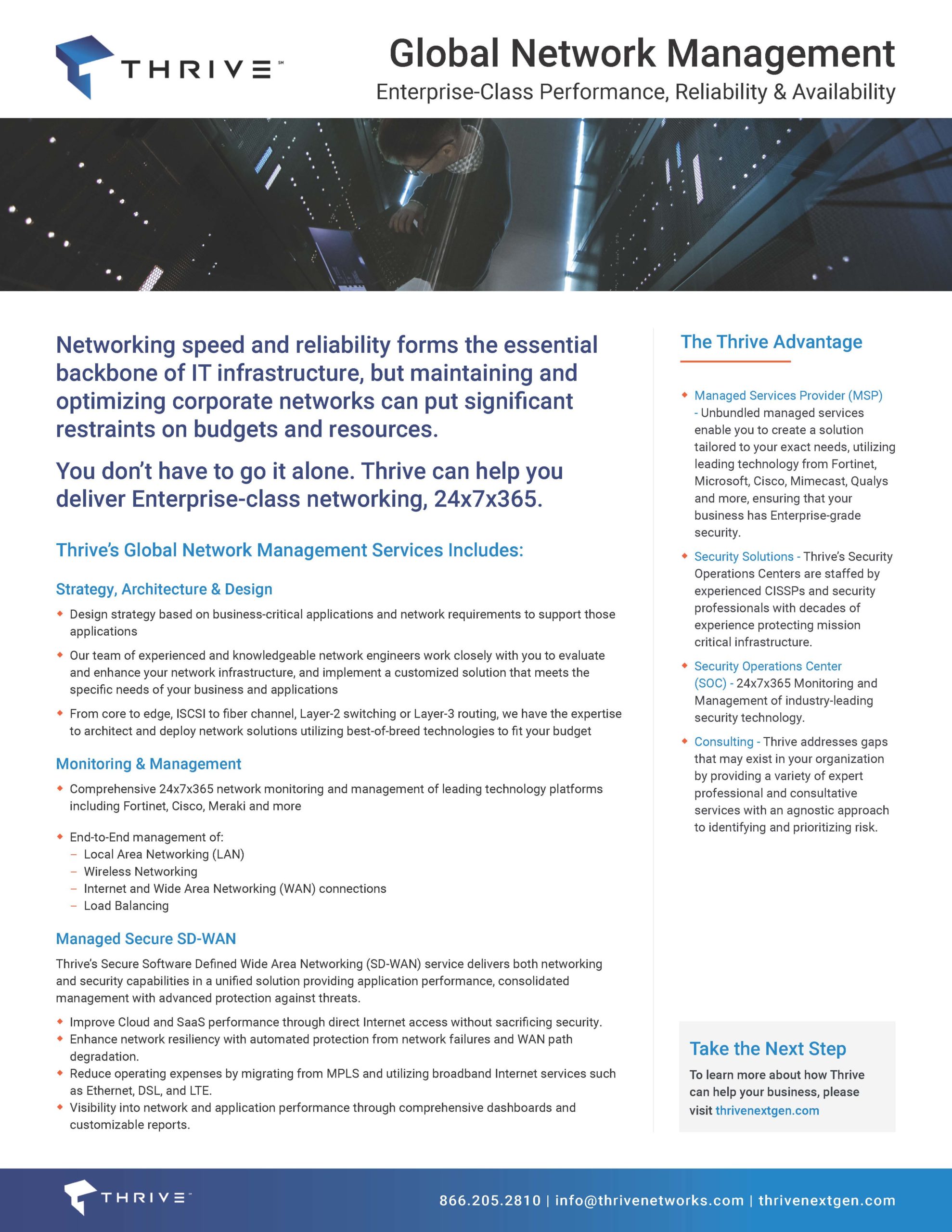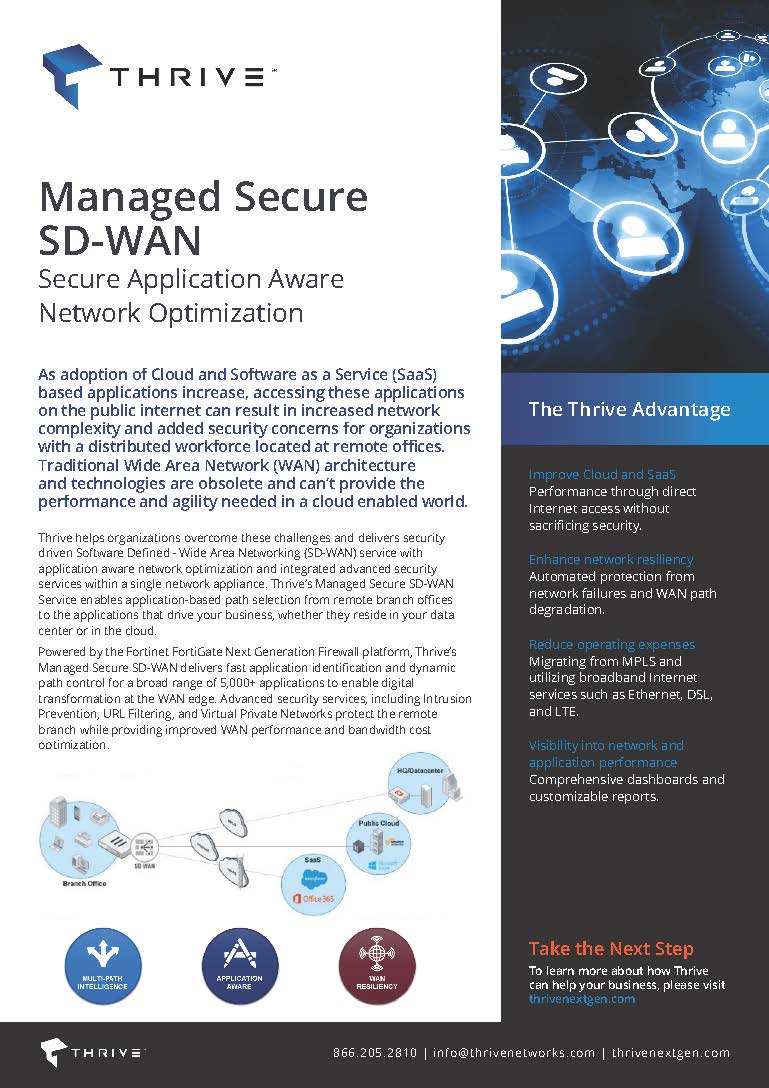Managed Network Services
Is the timing right to outsource your Cloud services?
How can the Cloud enable you to meet your business goals?
Thrive can help.
Building networks with cost-efficient infrastructure and network management tools, optimizing bandwidth, balancing network loads, and securing traffic isn’t easy and takes expert planning and execution to enable networks to run smoothly and securely all the time.
You don’t have to go it alone with Thrive. Partnering with a technology provider like Thrive, gives you peace of mind that your network systems will be available and performing at their best 24/7 without interruptions and downtime.
Modernizing Your Network
From troubleshooting network issues, to identifying and managing security threats, to performance monitoring of network traffic and infrastructure, managed network services are essential in today’s business climate and network downtime is something you can’t afford.
However, network system administrators may be following an outdated playbook. Most of today’s networks were designed and built long before today’s bring your own device (BYOD) trend of employees using personal devices to connect to an organization’s network and access work-related applications.


What Are Managed Network Services?
Managed Network Services are the processes, tools, hardware, software, and applications used to operate and maintain a network infrastructure at optimal performance. The end goal is to make sure the network resources are made available to users and consumed as efficiently as possible.
The ISO network management framework divides processes into 5 main functional areas below. Commonly referred to by the acronym FCAPS, each area relates to a high-level IT management process.
- Fault management
- Configuration management
- Accounting management
- Performance management
- Security management
Maximizing Your Organization’s Network
Networking speed and reliability form the essential backbone of IT infrastructure for every business. However, maintaining and optimizing corporate networks efficiently can put significant restraints on budgets and network resources.
Thrive provides expert NextGen managed networking solutions that enable your business to run at maximum efficiency with the room to scale simply and affordably. Unlock valuable, industry-leading, and comprehensive insight into the performance of your network while delivering the speed and security your business and end users demand.


Driving Better Business Outcomes
“Thrive’s responsive approach to compliance and regulatory requirements was instrumental during implementation. As a result, Thrive’s support has been crucial in maintaining client trust and ensuring our network’s security meets high standards, safeguarding our business from significant financial and reputational risks”
Wesley Price, IT Director, Gray, Rust, St. Amand, Moffett & Brieske (GRSMB)
Why Outsource Your Network Management to Thrive?
Thrive helps you take advantage of efficient and available networks to drive greater performance and value for your business. Thrive’s equipment-based managed NextGen network services produce bandwidth cost savings and eliminate costly hardware, providing you with more cost control and flexibility.


Stay Competitive with Top Technologies
Thrive ensures that your business is using the latest technologies and equipment, and keeps you informed with strategic advice to keep your business moving forward. We help simplify the management of your technology stack so that your staff can perform at an optimum level, no matter where they are located. Our dedicated team provides 24x7x365 monitoring to detect threats early and mitigate them quickly. Thrive works with you to ensure that your network is safe at all times, including timely updates of the newest antivirus and firewall upgrades to your system.
Deliver Continuous and Effective Service Levels
Thrive’s managed network services aim to improve employee productivity with time-saving updates. With Thrive, your organization will be able to reduce network performance issues that can impact employees’ ability to access resources and platforms required to perform their jobs.
Maintain Business Continuity Despite a Disaster
Thrive’s Disaster Recovery as a Service (DRaaS) is here to ensure your business stays up and running when mission critical systems are unavailable due to infrastructure failure, security breach, human error, or a natural disaster. Thrive’s services allow:
- Your data and IT resources are safely centralized in an off-site location with Cloud backup.
- All your service reports, performance information, job tickets and even call logs, are safe and secure with Thrive.
- Even during a natural or man-made disaster, your business can go on with very little interruption.
Proactively Manage Network Risk
Thrive manages the risk of staying up-to-date on new government regulations, changing industry policies, security and environmental compliance issues, altered economic conditions, changing technology, and fluctuating markets. Thrive identifies and troubleshoots network risk immediately with swift and corrective action. Maintaining compliance and security measures are also critical for protecting your clients’ confidential information.
Thrive’s Managed Networking Solutions Include:
Architecture & Design
- Our team of experienced and knowledgeable network engineers work closely with you to evaluate and enhance your network infrastructure, and implement a customized solution that meets the specific needs of your business and applications.
- From core to edge, ISCSI to fiber channel, Layer-2 switching or Layer-3 routing, we have the expertise to architect and deploy network solutions utilizing best-of-breed technologies to fit your budget.
Monitoring and Management
- 24x7x365 network monitoring and management of leading technology platforms, including Fortinet, Cisco, Meraki, and more
- End-to-end management of:
- Local Area Networking
- Wide Area Networking
- Wireless Networking
- Internet Connectivity
Managed Secure SD-WAN
- Thrive’s Secure Software Defined Wide Area Networking (SD-WAN) service delivers both networking and security capabilities in a unified solution providing application performance, consolidated management with advanced protection against threats
- Application-aware routing to ensure critical application performance metrics are met
- Multi-path intelligence providing automated failover and load balancing
- Integrated NextGen security threat protection eliminating the need for multiple point solutions
- Visibility into network and application performance
- Reduced total cost of ownership and operating expense
Our Latest Managed Network Services Resources
Support your organization’s need for improved network services with Thrive.
Streamline Your Global Network with Our Comprehensive Management Services
Improve your global network with our managed network services that ensure seamless performance, stronger security, and proven reliability.


